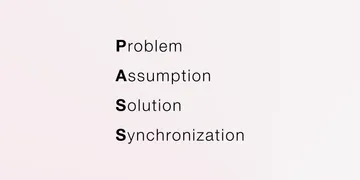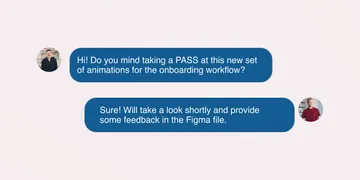Take a PASS at Collaborative Estimations

Digital Project Managers face many challenges when estimating projects. The PASS framework is one way to collaboratively improve the process (and accuracy) of project estimation.
I recently had the privilege of speaking at this year’s Digital PM Summit, a gathering of digital project managers coming together to learn and network over keynotes, lightning talks, and community conversations.
I gave a lightning talk, Estimating for Success, that explored the challenges PMs face when estimating within projects, collaborative feedback strategies, and methods for estimating more accurately. This article will dive more deeply into one of those methods: the PASS framework.
Introducing the PASS Framework

The PASS framework, which stands for Problem, Assumption, Solution, Synchronization, is an asynchronous approach to collaboration that encourages team members to effectively identify and address issues, assumptions, and potential solutions. During my talk, I discussed applying it in creating and maintaining estimations throughout a project. You can ask your teammates to “Take a PASS” as a method of asking for help in identifying problems and finding solutions when you need to create or adjust estimations and expectations.
Let's break down each of the four components of this framework.
Problem
The first step in the PASS Framework involves identifying and stating problems or issues that team members might encounter. This step requires clear communication about what might not be going as planned or what specific aspect of the project isn't meeting expectations. The emphasis here is on transparency and clarity, making it easier to pinpoint and understand the challenges the team is facing.
Assumption
After identifying the problem, the next step is to make an assumption about why the problem exists or clarify why it's a problem in the first place. These assumptions can be based on various factors, such as functionality, design, or other aspects of the work. Assumptions play a crucial role in the process, as they help in surfacing any confusion in understanding between teammates.
Solution
Once the problem and assumptions are laid out, the next step is to recommend a solution. Team members are encouraged to brainstorm and propose potential solutions to address the identified problem. It's important to foster an environment where team members feel comfortable sharing their ideas and collaborating.
Synchronization
The final step involves aligning on the information gathered and any decisions made. This means updating documentation, informing the entire team, and ensuring that stakeholders are aware of the discussions and decisions made. Synchronization is crucial for maintaining transparency and keeping everyone aligned on the project's progress and changes.
PASS in Practice
Let’s use an example where we have asked a developer on our team to review some design animations for a project on a tight budget. We might leave a comment in a design file saying, “Can you please take a PASS on these new onboarding workflow animations to see if they need revised estimates?”
This will prompt our teammate to not only review the work but to also think critically about any concerns raised during that review. The PASS framework also asks them to think about their assumptions and give feedback to communicate their concerns. This feedback can be delivered via a comment on a working file, a Slack message, or any other communication channel.

Start with, P, Problem. In this example, our developer may express concern about the complexity of animations in the onboarding flow, with regards to the time it will take to build versus the time currently budgeted for this work.
Then, A, Assumption – they might assume that the strategy behind the complex animations is to guide and delight the user through onboarding. They communicate that assumption as part of their feedback. By communicating their assumption, they are demonstrating their understanding and providing an opportunity to confirm that everyone is on the same page.
Next, S, Solution – the developer may ask for, or even suggest, a more simplified approach to the animations, making them easier to complete within the current estimation. Or, they might propose revisiting the currently budgeted time to better accommodate the higher estimation for the more complex work. The types of solutions available and the ways they are presented will be different from task to task and project to project.
Finally, S, Synchronization. The discussion and any decisions made should be documented and communicated to the broader team and any stakeholders involved.
Benefits of the PASS Framework
There are a few key benefits to utilizing this framework when working collaboratively and with remote teams.
- By encouraging team members to express any problems or assumptions, and help identify potential solutions, the project manager is helping to continually foster open and transparent communication within a team.
- The framework promotes active collaboration, resulting in more effective solutions and better outcomes.
- Synchronization prevents miscommunication and ensures that all project documentation is up-to-date.
So, what do you think? Are there opportunities in your organization to ask your team to “Take a PASS” in your project workflows? If you have any thoughts on PASS or have a good framework that you use to help your team collaborate, send me a note and let’s chat about them!
